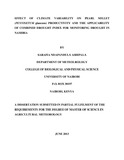| dc.contributor.author | Ashipala, Sarafia N | |
| dc.date.accessioned | 2013-07-31T13:51:36Z | |
| dc.date.available | 2013-07-31T13:51:36Z | |
| dc.date.issued | 2013 | |
| dc.identifier.citation | Sarafia Ndapandula Ashipala (2013). Effect Of Climate Variability On Pearl Millet (penn/setum Glaucum} Productivity And The Applicability Of Combined Drought Index For Monitoring Drought In Namibia. Master Of Science In Agricultural Meteorology | en |
| dc.identifier.uri | http://erepository.uonbi.ac.ke:8080/xmlui/handle/123456789/53099 | |
| dc.description.abstract | Climate variability has been one of the most important determinants of crop productivity in the
world. Pearl millet farmers in the northern parts of Namibia always encounter poor pearl millet
yields due to intra-seasonal characteristics and climate variability. Specifically, the dry spells that
always occur across pearl millet growth stages and recurrent droughts adversely affect crop
productivity. The overall objective of this study was to assess the effect of climate variability on
pearl millet (Pennisetum glaucum) productivity and explore the usefulness of the Combined
Drought Index for agricultural drought detection in Namibia. The specific objectives of the study
were to determine the effect of the length of growing period, the length of dry spells that occur
during pearl millet growth stages and rainfall anomaly on pearl millet yields. The study also
evaluated the possibility of using the Combined Drought Index (CDI) as an indicator for early
agricultural drought detection in Namibia.
The study used correlation analysis to determine the degree of association between the study
parameters. Instat Statistical Analysis Software was used to perform climatic analysis, whereby
soil water balance was used to determine season length and the occurrence of dry spells (dry
days) during the pearl millet three major growth stages. Monthly rainfall and temperature for
fourteen years (1998- 2012) as well as the Normalized Difference Vegetation Index (NDVI) data
were used in the analysis. Estimated daily rainfall for Ondangwa, Outapi and Ongenga were also
used in the analysis of this study.
The study revealed that the effect of length of growing period, dry spells and rainfall anomalies
on pearl millet yields varies from region to region and also with pearl millet growth stages. There
was also significant influence of lengths of dry spells that occur at growth stage one (GS1) in
Oshana and Ohangwena, growth stage two (GS2) in Omusati and growth stage three (GS3) in
Ohangwena on pearl millet yields. The Combined Drought Index (CDI) was able to capture the
historical drought events experienced in Namibia. The study, therefore recommends the use of
the Combined Drought Index as a third agricultural drought monitoring and detection indicator
in Namibia. | en |
| dc.language.iso | en | en |
| dc.publisher | University of Nairobi | en |
| dc.title | Effect Of Climate Variability On Pearl Millet (penn/setum Glaucum} Productivity And The Applicability Of Combined Drought Index For Monitoring Drought In Namibia | en |
| dc.type | Thesis | en |
| local.publisher | Department of Meteorology | en |

